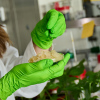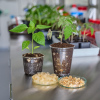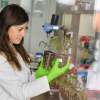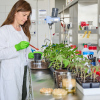Agrohydrogel from renewable raw materials to increase soil retention
Technology description
| The name of the technology: | Agrohydrogel from renewable raw materials to increase soil retention |
|---|---|
| Challenge: | Due to persistent periods of drought, new technical measures are being implemented in agriculture in order to increase water retention in the soil. One of such measures includes the application of polymeric absorbent materials – hydrogels, which are characterized by the ability to bind a large amount of rainfall or irrigation water in their 3D polymer network and release to the soil for plants during the dry season. Hydrogels also have a positive effect on the permeability and structure of the soil and support its microbiological activity. Research published so far have focused on the use of synthetic petroleum-based polymers or combination of natural polymer materials such as polysaccharides, proteins with synthetic polymers based on acrylic acid or acrylamide. However, these solutions still have shortcomings, as cost-inefficient and non-degradable materials based on petroleum products and synthetic cross-linking agents, which are harmful to the environment, are still often used. |
| Description: |
The hydrogel is characterized by its reversible ability to bind and release a large amount of water compared to its original weight, thereby ensuring the availability of water to plants during drought conditions. All raw materials that are used for the preparation of the hydrogel are environmentally friendly with low costs for the production process compared to common commercially available polyacrylate-based hydrogels. The base material for preparing of hydrogel is acid whey, a by-product of the dairy industry arising from the manufacture of cream cheese and Greek yogurt. However, a major proportion of acid whey from dairy industry is discarded as effluent, constituting a form of pollution. By using acid whey for the production of hydrogel, waste products from the dairy will be minimized and, thanks to the rich nutritional composition of whey, it can also contribute to increasing the availability of nutrients in the soil for plants. Another main component of the hydrogel are cellulose derivatives (carboxymethyl cellulose and hydroxyethyl cellulose), which form a stable three-dimensional network by cross-linking reaction with citric acid, ensuring the desired functions of the hydrogel. Hydrogel can be applied to the soil in the dried form of powder, crystals or granules by plowing. After application and contact with water, the dried hydrogel swells and forms a stiff gel, which is able to retain a large amount of water compared to its original weight. Polylactid, a low-molecular biopolymer that was synthesized from lactic acid, was incorporated into the hydrogel matrix in order to improve the mechanical properties of the material and contributes to the gradual release of water and nutrients from the hydrogel into the soil over a longer period of time. Thanks to the high content of nutrients in the whey, the hydrogel also contributes to enriching the soil with nutrients that support the growth of cultivated plants. Hydrogel can also be enriched with other organic substances, e.g. fertilizers, which are beneficial for plant growth. Through its action, the hydrogel also supports the activity of soil microorganisms, thus increasing soil biodiversity and soil quality. The hydrogel also affects the structure, permeability and other important properties of the soil. |
| Commercial opportunity: | Agrohydrogel represents a new type of easily degradable absorbent material, a currently unavailable product on our market. Agrohydrogel is made from environmentally friendly and low-cost raw materials, which can be successfully applied instead of commercially available synthetic hydrogels based on acrylate. Due to its high ability to repeatedly bind water and release it to the soil when there is a lack of moisture, this material finds application in agriculture, horticulture or forestry to increase water retention in the soil and support plant growth. Applying 1-2% of the hydrogel to the soil will help to increase the water retention of the soil by 30-40%, which can help to reduce the need for irrigation and thus lower the cost of cultivation. Agrohydrogel is also characterized by excellent degradability compared to commonly used synthetic hydrogels, whose decomposition products can persist in the soil for many years. Agrohydrogel is easy to apply in the form of granules, powder or stiff gel. Hydrogel can be incorporated into the soil by plowing (on the field) or burying to the soil (in boxes, planters) or using disposable plastic bags. Thanks to the original formula, the hydrogel contributes to improving the quality of the soil. Due to the high proportion of whey contained in the hydrogel, it is also possible to contribute to more efficient economic use of waste acid whey, thereby reducing the costs of its disposal and at the same time reducing negative impacts on the environment. Dried agrohydrogel has a long shelf life - it can be stored in airtight containers for at least two years. |
| IP protection status: | Registered utility model of the Czech Republic No. 35728 |
| Development status: |
Phase 3Corresponds with TRL 5 and TRL 6 Technology validation and implementing it in real environment. Testing the technology outside of the laboratory and its adjustment to external conditions.
|
| Partnering strategy: | Collaboration licensing |
| More information: |
https://isdv.upv.cz/doc/FullFiles/UtilityModels/FullDocuments/FDUM0035/uv035728.pdf http://cps.utb.cz/cs/aktuality/1036-ekologicky-setrne-hydrogely-ze-syrovatky-pomohou-v-boji-proti-suchu |
| Images: | |
| Categories: | Agriculture Chemistry |
| Institution: | Tomas Bata University in Zlín |
| Owner of a technology: | Univerzita Tomáše Bati ve Zlíně |




